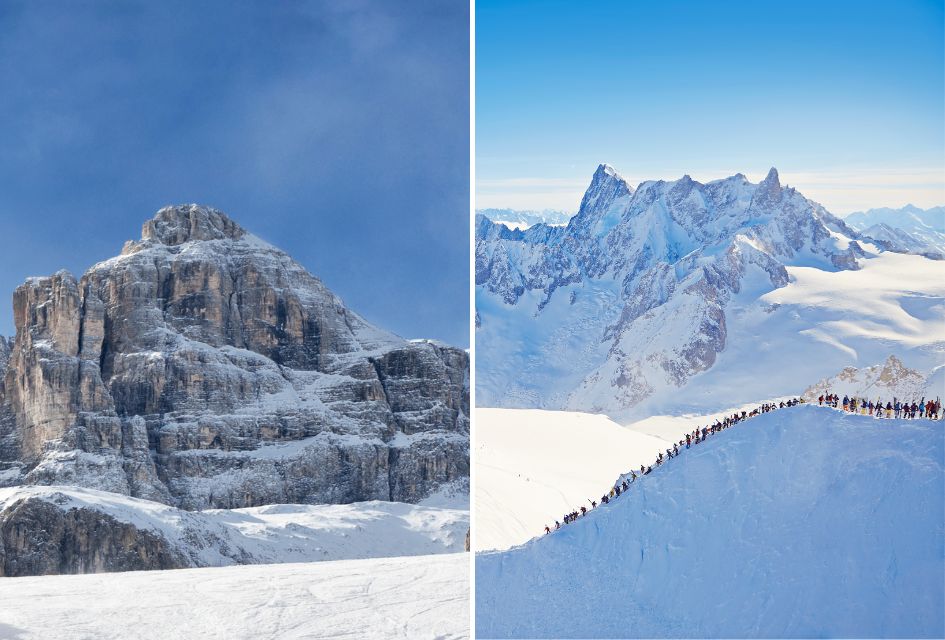
Two countries, both alike in ski-ability… but does one top the other? In the discussion of the French Alps vs the Dolomites, there are no losers. Both regions represent some of the best skiing and snowboarding opportunities in the world, fascinating cultural pasts, and undeniably exciting adventures to be had.
So, if you’re deciding between France and Italy for your next luxury ski holiday in Europe, then let us break it down for you. In this blog, we’ll cover the differences and similarities so that you can decide for yourself where suits you best.
And who knows? Maybe you’ll be so convinced by both that you’ll be making several trips to the mountains this winter…
The Ski Experience
Mont Blanc. Tre Cime di Lavaredo. Aiguille du Midi. Marmolada. It’s impossible to name all the incredible mountains across France and Italy without marvelling at the number as well as their exquisite natural beauty. The mountains certainly compare in the French Alps vs Dolomites debate. But what about the pistes?
Skiing in The Dolomites
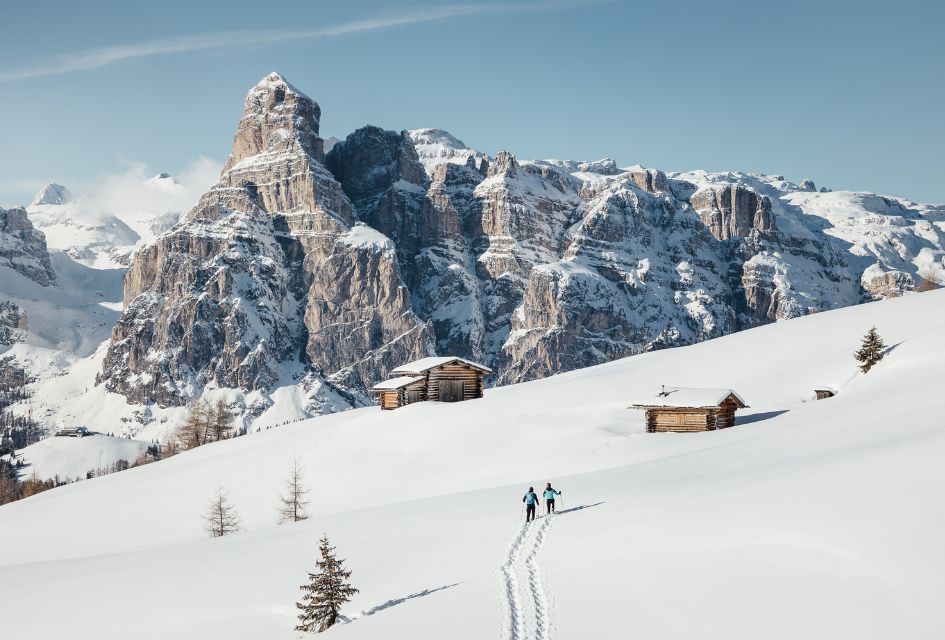
Jagged limestone peaks, sunny terraces, and elite snow-making infrastructures cement the Dolomites as a bucket list ski holiday destination. The numbers are undoubtedly impressive as well. The Dolomiti Superski pass grants access to over 1,200km of pistes spread across 12 ski areas. While not all of these connect in a single network, the famous Sella Ronda circuit and surrounding resorts like Alta Badia and Val Gardena showcase some of the most scenic and rewarding linked terrain in the Alps. Even when Mother Nature doesn’t play ball, the Dolomites manage to keep pistes in excellent condition thanks to one of the most advanced snow-making systems in the world. With so much skiing at mid-altitude, that reliability matters.
The skiing will particularly suit the explorers of the ski world. You’ll find endless reds and cruisy blues winding through the mountains and spectacular views at every turn. While the terrain is not quite as intense as some French resorts, there’s still scope for advanced skiers. This is especially true around Arabba and Cortina d’Ampezzo, two of the best resorts in the Dolomites, where things get a bit more technical. For luxury ski holidays in the Dolomites, families would likely enjoy a trip to Selva Val Gardena, where the family-friendly atmosphere begets an easy and seamless experience for everyone.
It’s also worth noting that when it comes to skiing in France vs Italy, the latter is considered a more relaxed experience. Lift queues are generally shorter, the pace a touch slower, and the scenery arguably more dramatic; it’s simply the Italian way! You might not clock quite as many kilometres in a day compared to the mega-resorts in France, but you’ll be stopping more often to take it all in.
Skiing in The French Alps
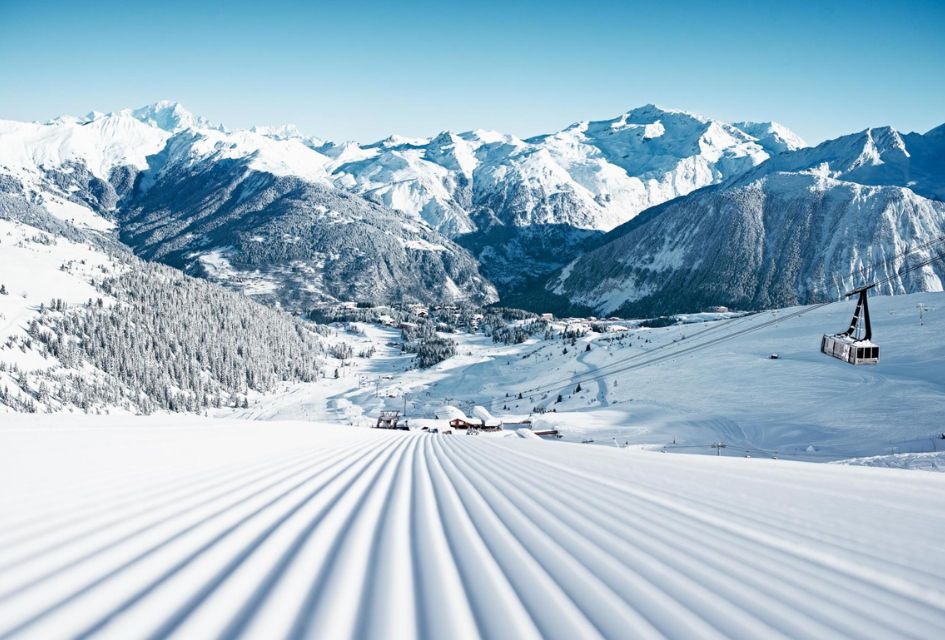
Next, we look to the French Alps, home to the largest interconnected ski area in the world: Les 3 Vallées. The sheer mass of this region, boasting 600km+ of skiing, is enough to make North American skiers gasp. In addition, the French Alps are also host to the other largest ski area in the world: Portes du Soleil. Though not interconnected, the 600km of skiing more than makes up for it. Granted, it does cross into Switzerland. But that’s just another perk of a ski holiday in the French Alps; the borders seem blurred when your lift pass covers so much ground.
Another pressing question is, who is best suited to skiing in the French Alps? If you’re looking for backcountry skiing in France, head to Sainte Foy, a resort for the purists. Here, you can also explore the quaint village and the nearby Tarentaise Valley, home to the Tignes-Val d’Isère ski area, with renowned height, snow security, and après-ski. Families often find Morzine to be a great choice; it’s a perfect beginner’s ski resort and is just 1.5 hours from Geneva Airport, not to mention Morzine’s luxury chalets! While there’s terrain for all levels in the French Alps, intermediate and advanced skiers may get more from the experience, as they can cover more ground. But for beginners, there’s always lessons! Take a look at our Ski School resource list for more information.
The French Alps generally have a superb snow record. The heights of the peaks vary, but France is proud to be home to the highest ski resort in Europe. In Val Thorens, the tallest skiable peak is Pointe du Bouchet at 3,230m, accessible from across the 3 Vallées via the modern lift network and well-maintained pistes. Thanks to the expansive acreage and variety, there’s something for everyone.
Aperitivo & Après-ski
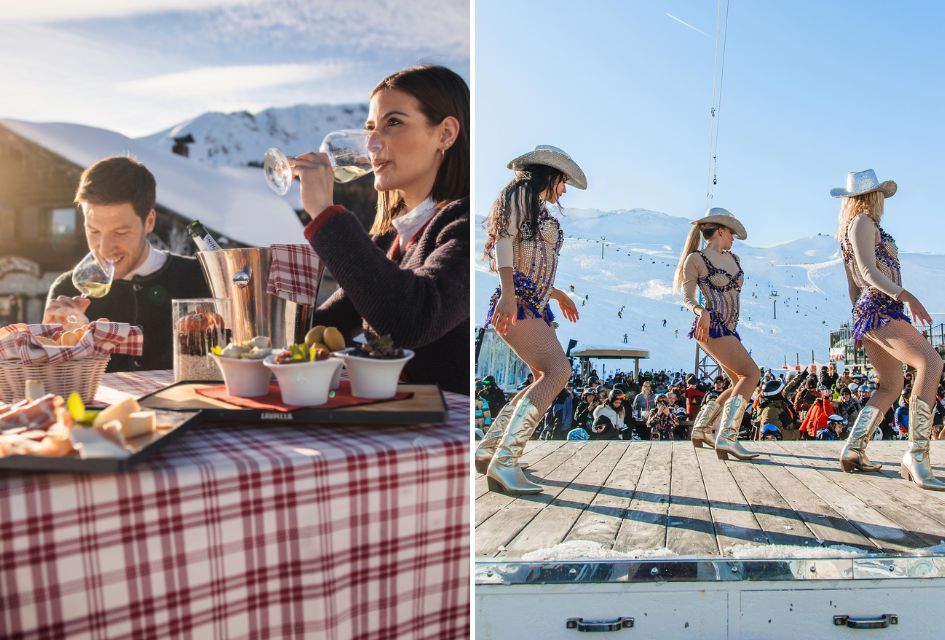
After taking on the mountain, there comes a time when the pull of the après-ski bars gets intoxicating. But will you be having an Aperol Spritz or a Bière Pêche as your first après-ski tipple this winter?
Après Culture in The Dolomites
Like France, the Dolomites is more than ready to entertain holidaymakers after a day on the mountain. However, the style of après is quite different from the Alps. Italy’s mountainous regions are immersed in their history and culture, and the act of sharing it is what makes visitors feel so at home there. Food, as you may know, is a key part of how Italian citizens share that culture. Often with your drinks in Italy you’ll receive a complimentary array of charcuterie, cheeses, and breads, an ideal way to begin a night of partying.
In addition, visitors usually enjoy mountain drinks in smaller establishments where authenticity is at the heart. The rifugios (mountain huts) are the best spots for scenic views to pair with a Bombardino and a crackling fireplace. Laughs are shared amidst conversation as cheeks become more rosy, and you almost feel as though your evening of drinks is happening in your own home, with an added spritz of La Dolce Vita. What’s more, you can dodge queues for bars in the Dolomites. The numerous smaller establishments and spaced-out resorts have made way for a far more laid-back drinking environment away from crowds!
Après Culture in France
France’s après-ski bars are some of the best in the world. Obviously, the word itself comes from the French language, and the legendary après at La Folie Douce is a booming presence across the French Alps after its inception in Val d’Isère. Typically, French après is loud and proud, with energetic crowds, thudding ski boots dancing until sundown, and never-ending drinks flowing.
However, France is equally famous for its exclusive resorts, and with that comes upscale establishments for refined après-ski. Think Courchevel 1850, with its boutique shopping and ski-in, ski-out pistes, all surrounded by some of the best slopes one can find. The après-ski in Courchevel certainly matches, with a harmonious blend of elegant bars and lavish clubs. On your luxury ski holidays in the French Alps, the apres-ski can be as upmarket (or not) as you want!
Dining & Cuisine
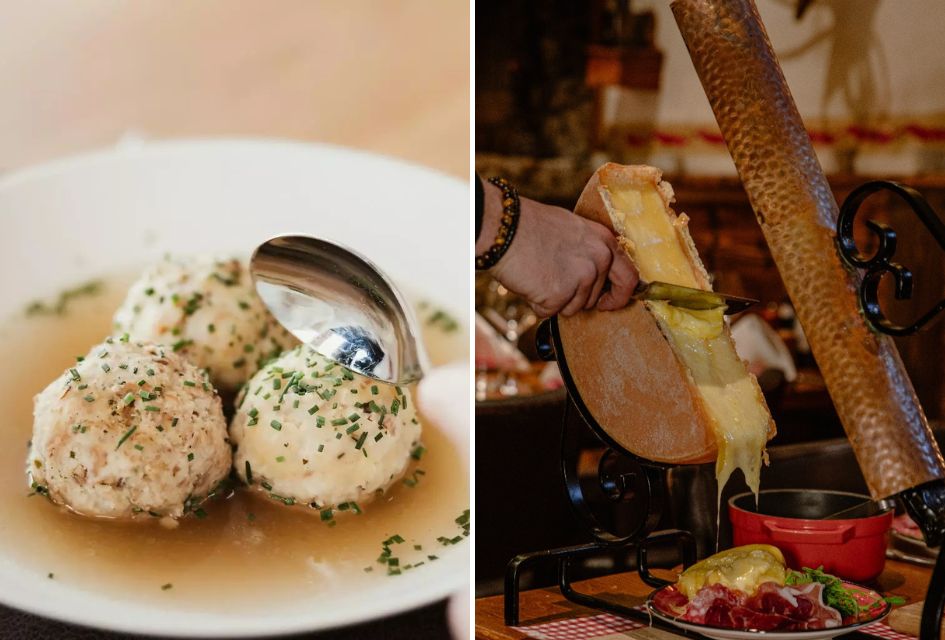
So, you’ve finished with the afternoon festivities and exhausted all of your après-ski energy. Maybe you’ve had some time to relax in the very best luxury mountain spas, or you’ve accomplished some boutique shopping while the mood is high. At this time, hunger may be starting to set in. After all, you’ve done plenty of skiing and socialising all day; you deserve some truly divine dining to round out the day! Mountain cuisine is in a league of its own, whichever country you’re in. So it’s no wonder that the Dolomites’ and Alps’ cuisines are something special and distinct.
Mountain Cuisine in the Dolomites
All the best restaurants in the Dolomites are exemplary, showcasing not only regional food but the best of international gastronomy. They demonstrate how culture and cuisine intersect across every tier of dining, from a rustic and homemade style bursting with flavour to a refined and artistically presented plate with global acclaim. If you journey to Brunico, you can get a taste of the latter. Atelier Moessmer, headed by Norbert Niederkofler, is the place to be for gourmet delights, coinciding with an eco-conscious food ethos. Whether you seek the art in food or authentic simplicity, a Dolomites ski holiday will deliver.
In the mountains of Italy, you can, of course, expect the classics: pizza, pasta, and a fabulous tiramisu to finish. However, due to its proximity to surrounding borders, plus its vivid, varied history, mountain dishes in Italy may surprise you. The Ladin tastes are earthy, satisfying, and above all, delicious. Pictured above (left) is a characteristic regional dish: Bales da cioce, aka speck dumplings, surrounded by a warm, healing broth. Often an appetiser before your main dish or served alongside a traditional barley soup, this nutritious dumpling is an excellent winter warmer; in every bite, you can taste both the region’s flavours and the history that lies in the mountains.
Culinary Offerings in the French Alps
In the French Alps, dishes tend to centre on the pride of the mountains: cheese! Savoyard dishes are a melting pot of funk and richness, with cheeses harvested locally from the alpine cows as well as their high-quality meats, with some form of carbohydrate to bind it all together. Take Tartiflette, a regional classic. In this dish, you’ll find layers of potato with slices of local Reblochon, bacon lardons weaving throughout, and a delightful crust from a high heat at the end. There’s nothing better on a cold winter’s day than a never-ending cheese pull paired with potato.
It’s the same for fondue or raclette, where more melted cheese envelops bread, cured meats, and cornichons. It’s a combination that can do no wrong! Perfect for sharing between friends, social dining is the name of the game in such dishes; however, there are naturally as many fine-dining offerings in the French Alps as there are home comforts. For example, Courchevel’s Michelin-Starred restaurants are some of the finest you could experience, with Le 1947 à Cheval Blanc topping the list with the coveted 3-star designation. France boasts the highest number of Michelin stars out of any country, so skilled chefs aren’t too surprising. Thanks to the overwhelming pull of the French Alps, a lot of them are drawn to the mountains, a great benefit for the skiers that visit!
Needless to say, no matter which you choose in the Dolomites vs French Alps battle, you’ll leave with a full stomach!
Luxury Ski Chalets in the Dolomites vs the Alps
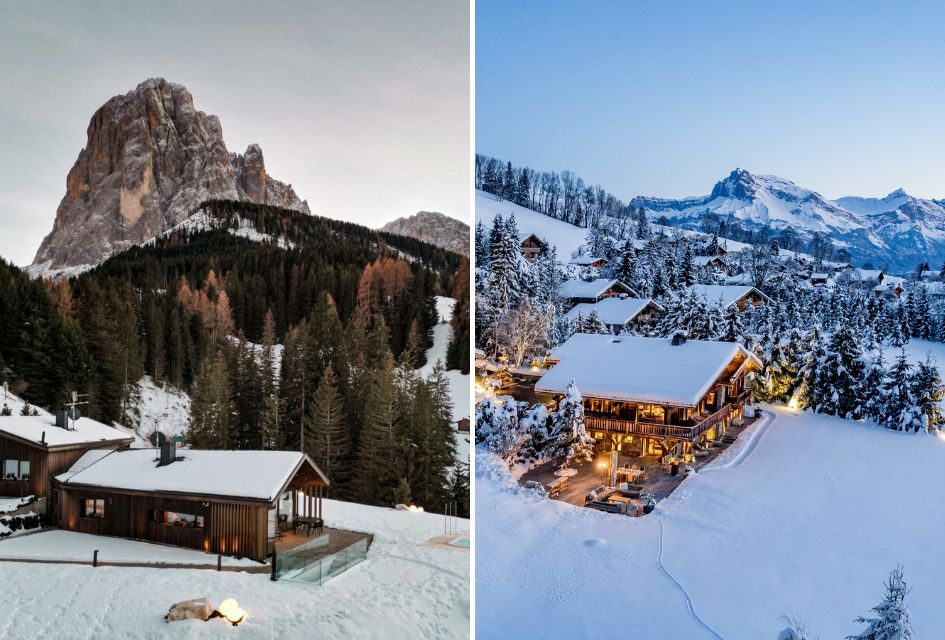
Stylistically, there are distinctions between luxury chalets in the Dolomites and the equally opulent chalets in France. While both emphasise craftsmanship, high-end services, slope access, and wellness, there are tells that signpost the location. Italy is, compared to France, later to the ski tourism boom. Hence, the number of luxury chalets and apartments in the Dolomites is more limited in comparison. French resorts are often built with the ski industry and infrastructure in mind, differing from Italy’s more anachronistic villages. However, they still maintain a charming atmosphere, a certain je ne sais quoi, if you will.
Chalets in Italy are often independently owned passion projects, each with a unique spin. You’ll never find the same stay twice in Italy, with a unique quality to each property and a sense of excitement and surprise. In the Dolomites you have individual villages that are just that: villages first, skiing an additional perk. You’ll find chalets owned by Italians and certainly operated in a local-focussed mindset. Hence, your holiday experience is very personalised and authentically toned. You can really feel the sense of Italian national pride and the importance of local heritage in the Dolomites!
In the French Alps, since there’s more development, there’s a larger range of luxury chalets. Service levels are also more ‘traditionally’ high-end, with a formal French training style to chalet teams. The French chalet style is also a little more standardised, as developers tend to select from a set pool of high-end Alpine designers. Of course, this is dependent on exactly which resort, with chalets in Courchevel 1850 or Megeve perhaps being a little more on the extravagant side, while St Martin de Belleville demonstrates understated luxury, with a close connection to its farming heritage.
So, Dolomites vs Alps. Which chalet should you choose?
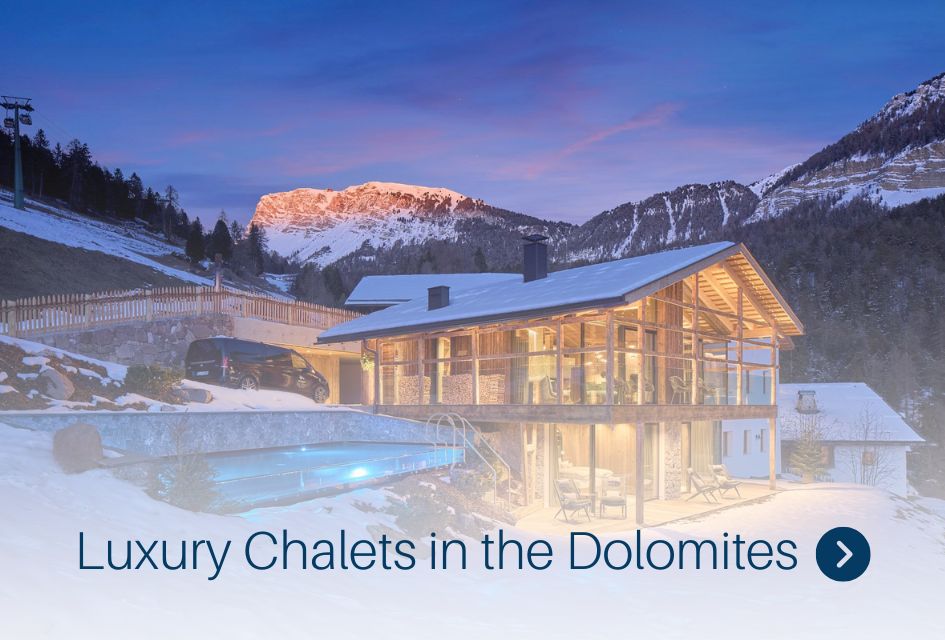
Why Rent a Chalet in the Dolomites?
- You value the individuality, the personality, and the journey down to the untouched area that you wouldn’t otherwise explore.
- Experience unique stays through the lens of Dolomiti heritage and authentic hospitality.
- You appreciate a ski area comparable to an independent café, with a distinct grassroots feel, and without compromising on luxury.
- You like visiting a place where the locals set the pace in an area they have transformed for skiing themselves.
- You’re inspired by the passion of every person, from chalet owners to hospitality teams, for preserving the character of their home.
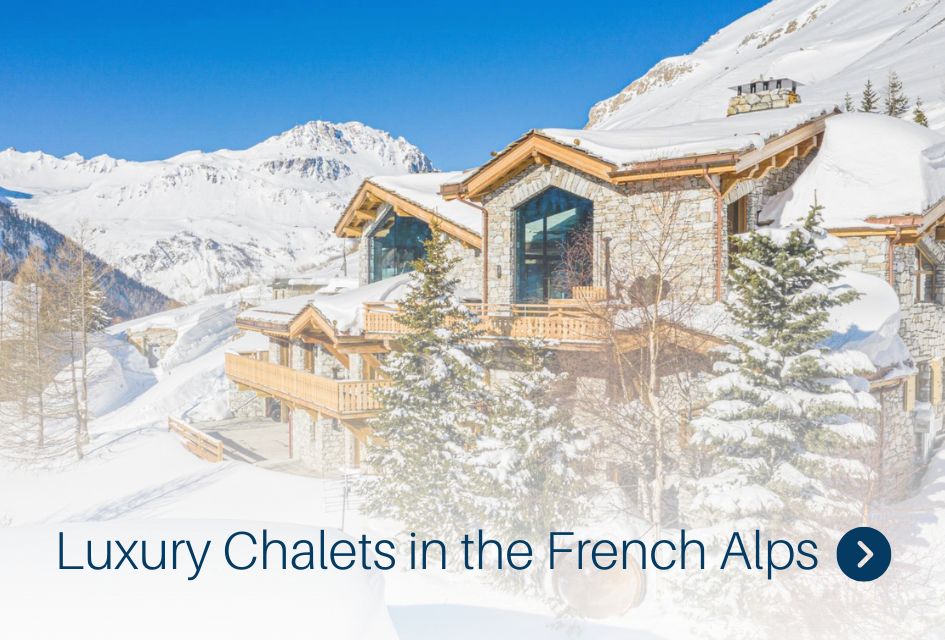
Why Rent a Chalet in the French Alps?
- You appreciate resorts that are well-established and practiced in mountain tourism.
- A ski town where the infrastructure has been conveniently designed for ski holidaymakers is a dream-come-true.
- You seek what most people think of a luxury catered chalet in a ski resort.
- Over generations the art of alpine hospitality has been refined to perfection.
- The abundant charm in combination with the great amenities, and excellent access to slopes, chalet, and towns.
- You value a premium location for a chalet.

So after looking at the Dolomites vs Alps, where will you venture next? Our team of experts are brimming with knowledge of the best luxury ski chalets in France, Italy, and beyond. To enquire and learn more about ski holidays in the Dolomites vs the Alps, send an email to ask@skiinluxury.com, or call us on +44 (0)1202 203650.
In the meantime, keep up with the latest additions to our luxury portfolio, as well as holiday deals and offers, by following us on Instagram, Facebook, YouTube, and Pinterest.





